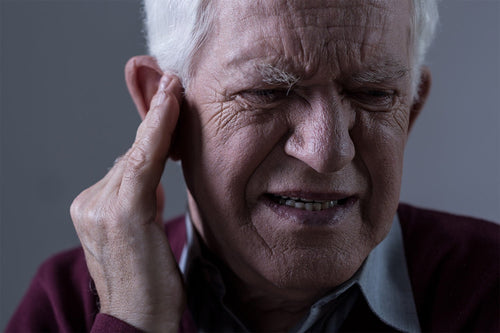Cookie bite hearing loss is a rare form of sensorineural hearing loss that affects a person’s ability to hear a specific range of frequencies. This hearing loss is called cookie bite, based on a graphical curve that can be seen when mapping out frequency sensitivity.
Hearing loss is one of the most prevalent forms of disability affecting the population. This particular hearing loss disorder can prevent a person from understanding everyday sounds, including speech.
Let’s take a closer look at what hearing loss is and cover important factors of cookie bite hearing loss.
Understanding General Hearing Loss
Millions of people experience hearing loss, and it is one of the most common forms of disability. There are many different factors that play into hearing loss, as it varies by person and the environments that people are exposed to.
For instance, genetic factors can pose a higher chance of developing hearing loss if one of your parents also struggles with sensorineural hearing loss. Loud noises can depreciate your ears’ ability to recognize sound waves; in addition, traumatic injury can also affect your ears’ natural ability to hear.
Let’s take a moment to get familiar with the major kinds of hearing loss and honing in on what cookie bite hearing loss is.
Types of Hearing Loss
For many people, when you experience hearing loss, you may not realize that you are experiencing it at first. They can understand the fact that they don’t have the same hearing capability as they did at an earlier time in their life - but the question of why may be unanswered.
The short answer is that your hearing threshold may be rising the more that your ability to hear depreciates. But what does that mean? Sounds travel through the air in waves of energy, vibrating at different frequencies. These waves are uniquely signature by the level frequency they have, and it correlates to the sound they are then interpreted into. As they travel, they have a natural force that they present to your ears with. That force is measured by decibels.
For instance, a soft-spoken person talking to you in a crowded subway station will have to forcibly raise the power of their voice for you to hear them over the sound pollution of the subway station. When we experience hearing loss, our natural ability to hear sound waves at low decibel levels gets taken from us.
As our ability to hear goes down, our threshold for what decibel we recognize sound begins to go up. Suddenly, soundwaves that used to present at a lower decibel need to be pushed to a higher decibel in order to be heard.
With cookie bite hearing loss, the range of frequencies affected is 500 to 2000 Hz. This range of frequencies, unfortunately, has many common sounds in it - such as speech. This is known as the mid-range frequency type of hearing loss.
Conductive Hearing Loss

When it comes to hearing loss, there are three different types that people can suffer from. These three types of hearing loss can have multiple causes, which in turn, there are several options for treatment that are available.
Conductive hearing loss is a type of hearing loss where sound waves are impeded from ‘conducting’ properly. This hearing loss is due to any kind of blockage that may take place in the ear.
The ear itself is composed of three compartments - the outer, middle, and inner ear. Any of these compartments can experience blockage that blocks a soundwave's natural ability to travel through the ear and interact.
Our middle ear has a tympanic cavity that houses three important bones: the stapes, incus, and malleus. These small bones are fine-tuned to interact with the tympanic membrane, more commonly known as the eardrum, as it vibrates due to sound waves that travel down the ear canal.
These bones vibrate very specifically in response to the tympanic membrane, and these vibrations interact with the inner ear.
Any blockage because of excess ear wax can be fixed easily. But, a traumatic injury where foreign objects may be lodged in the ear canal may come with more severe effects. In many cases, there may be damage to the eardrum or bones behind the ear which can be repairable.
While severe impairment can occur from some kind of traumatic conductive hearing loss, this type of hearing loss can be correctable. Although, it commonly doesn’t represent moderately severe to severe hearing loss.
Sensorineural Hearing Loss
This form of hearing loss typically represents more severe deficits in a person's ability to hear. As the name implies, this form of hearing loss deals directly with the neurological aspect of hearing.
At the inner ear, the cochlea is the area where these vibrations are taken and transformed into electrical signals that travel to your brain to be interpreted as sound.
When this process of translating the vibrations from the middle ear into electrical impulses in the inner ear is affected, it is called sensorineural hearing loss.
Audiogram and Cookie Bite Hearing Loss
An audiogram is a graph that shows the results of a hearing test. If you have suspected hearing loss and you talk to your primary care provider, most likely, they will point in the direction of hearing tests. These tests are non-invasive, painless and they simply assess the limits of your hearing capabilities.
There are several different kinds of hearing tests that a person typically needs to go through. An audiologist is a certified specialist that can conduct these tests that assess exactly what kind of hearing loss you may have.
The five major tests that you will receive are:
- Pure-Tone Testing
- Speech Testing
- Tests of the Middle Ear
- Auditory Brainstem Response
- Otoacoustic Emissions
These five kinds of hearing tests can assess not only what types of hearing loss you may be experiencing but what severity of hearing loss you have. When you look at your hearing test results on an audiogram, you see a graph where the decibel level is charted on the y-axis, and the frequency is charted on the x-axis.
Normal hearing usually has a threshold of or near zero. This translates to a person with normal hearing being able to hear a soft whisper. These thresholds are based on the frequency that the sound is emitted. So, as a person experiences hearing loss, they will notice their results dip out of the normal range on the y-axis and enter into higher decibel ranges.
Cookie bite hearing loss is specifically referring to an audiogram that shows a person's hearing dip into higher decibels on the y-axis during the 500-2000 Hz range. This can be shown as a fairly normal straight line from 0-500 Hz and then a dip until about 2000 Hz where it comes back into a normal range.
This creates a curve that some have suggested looks like a bite right out of a cookie - hence the nickname, cookie bite hearing loss.
Treatment for Cookie Bite Hearing Loss

The general causes of cookie bite hearing loss are genetic and can be considered a rare form of hearing loss. The good news, however, is that treatment is very accessible. This mid-range hearing loss does affect very important frequencies for sounds such as common speech.
For instance, some people who suffer from cookie bite hearing loss don’t experience strong symptoms unless there is a high level of sound pollution around them. This means that a person with cookie bite hearing loss can navigate social interactions that might exacerbate these symptoms.
Also, hearing aids can pose a very manageable treatment. These devices are designed to understand what frequencies you have trouble hearing and then boost those frequencies to a recognizable decibel threshold.
Choose Audien Hearing Aids
You may think that dealing with any type of hearing loss may be the end of the world. Cookie bite hearing loss can still be managed thankfully with the help of hearing aids. While hearing aids can come with hefty price tags, high-quality over-the-counter options can help with conditions like cookie bite hearing.
"No matter what type of hearing loss you have, Audien hearing aids offer an affordable solution to meet almost anyone's needs." - Drew Sutton, MD, Board-Certified Otolaryngologist.
Audien Hearing has worked hard to develop an over-the-counter hearing aid that will help improve your life without breaking the bank. Our EV1 and EV3 hearing aids utilize hearing technology that helps filter out background noise and focus on the sounds you want to hear. For information about how our product can impact your hearing loss journey, click here.
Source:
Anatomy and Physiology of the Ear | stanfordchildrens.org
Cookie-bite hearing loss: What is it? | healthyhearing.com
Types of Tests Used to Evaluate Hearing in Children and Adults | ASHA
Types of Hearing Loss | hopkinsmedicine.org
What does my audiogram mean? | boystownhospital.org
Deafness and hearing loss fact sheet | WHO
Hearing loss and deafness: Normal hearing and impaired hearing | NCBI Bookshelf













